Interested About The Differences Between SMILE, LASIK, And PRK Eye Surgeries?
Interested About The Differences Between SMILE, LASIK, And PRK Eye Surgeries?
Blog Article
Writer-Munksgaard Wilder
If you've been considering SMILE eye surgical treatment, you might ask yourself exactly how it stacks up against LASIK and PRK. Each procedure has its very own collection of advantages and factors to consider. From quicker healing times to potential risks, there are essential differences you should recognize before deciding. Understanding these distinctions will certainly help you make an enlightened selection that straightens with your details demands and expectations. Curious to know even more about exactly how these treatments contrast in detail? Go on discovering to gain a comprehensive understanding of SMILE, LASIK, and PRK.
SMILE Eye Surgical Procedure Review
If you're taking into consideration SMILE eye surgery, you'll find it to be a minimally invasive procedure with a fast recovery time. During SMILE (Little Incision Lenticule Extraction), a laser is used to create a tiny, accurate cut in the cornea to get rid of a tiny piece of tissue, improving it to fix your vision. This differs from LASIK, where a flap is produced, and PRK, where the external layer of the cornea is entirely eliminated.
One of the crucial advantages of SMILE is its minimally intrusive nature, causing a faster recovery process and much less pain post-surgery. The recovery time for SMILE is reasonably fast, with lots of clients experiencing enhanced vision within a day or 2. This makes it a popular choice for those looking for a practical and effective vision adjustment procedure. In addition, SMILE has actually been revealed to have a lower risk of dry eye syndrome compared to LASIK, making it a favorable option for people worried regarding this prospective adverse effects.
Distinctions Between SMILE, LASIK, and PRK
When contrasting SMILE, LASIK, and PRK eye surgeries, it's important to understand the unique strategies used in each treatment for vision modification.
SMILE (Small Cut Lenticule Removal) is a minimally intrusive procedure that includes creating a small incision to draw out a lenticule from the cornea, improving it to remedy vision.
LASIK (Laser-Assisted Sitting Keratomileusis) entails creating a slim flap on the cornea, utilizing a laser to reshape the underlying tissue, and afterwards rearranging the flap.
PRK (Photorefractive Keratectomy) removes the external layer of the cornea before reshaping the cells with a laser.
The primary difference depends on the method the cornea is accessed and treated. SMILE is flapless, making it a good choice for people with thin corneas or those associated with contact sports. LASIK offers fast visual recuperation as a result of the flap creation, yet it might position a higher risk of flap-related difficulties. PRK, although having a much longer recuperation period, avoids flap-related problems entirely.
Understanding these variances is essential in picking the most appropriate treatment for your vision correction needs.
Pros and Cons Comparison
To assess the benefits and disadvantages of SMILE, LASIK, and PRK eye surgical treatments, it's vital to consider the particular benefits and potential limitations of each procedure. how to know if i need cataract surgery uses the benefit of a minimally invasive treatment, with a smaller laceration and possibly quicker recovery time contrasted to LASIK and PRK. It likewise reduces the danger of dry eye post-surgery, a typical adverse effects of LASIK. However, SMILE may have limitations in dealing with higher degrees of myopia or astigmatism contrasted to LASIK.
LASIK surgical procedure provides fast visual healing and very little discomfort throughout the procedure. It's extremely reliable in treating a wide variety of refractive mistakes, consisting of nearsightedness, hyperopia, and astigmatism. Yet, LASIK lugs a danger of flap complications, which can affect the corneal structure.
cataract surgery quotes , while not as popular as LASIK, stays clear of developing a corneal flap, minimizing the threat of flap-related problems. It appropriates for clients with slim corneas or uneven corneal surface areas. Nevertheless, PRK has a longer recuperation time and might entail extra pain throughout the healing process.
Verdict
So, when it pertains to selecting between SMILE, LASIK, and PRK, consider it like picking the excellent set of footwear. SMILE is like a sleek, comfortable set of tennis shoes - fast and easy.
LASIK is a lot more like fashionable high heels - flashy and fast, yet with some prospective threats.
PRK resembles tough hiking boots - reputable and sturdy, but needing a bit even more time and effort.
Inevitably, the best choice relies on your individual demands and choices.
